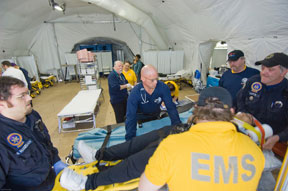 In an effort to mitigate the effects of future disasters, similar to Hurricane Katrina, the City of New Orleans Office of Emergency Preparedness recently purchased three state-of-the-art Deployable Rapid Assembly Shelter (DRASH) systems.
In an effort to mitigate the effects of future disasters, similar to Hurricane Katrina, the City of New Orleans Office of Emergency Preparedness recently purchased three state-of-the-art Deployable Rapid Assembly Shelter (DRASH) systems.
The military-grade, climate-controlled systems, which were purchased in December 2007, include a J Shelter (1,250 square feet), two M Shelters (748 square feet each), and one 6XB Shelter (413 square feet).
The systems will be used by the City for triage, treatment, and command and control in case of an emergency, or to simply relieve a surge of patients during large-scale events, such as the recent Mardi Gras celebration.
During Mardi Gras, the City set up four DRASH systems to be used as urgent care clinics for the final week of festivities. The clinics answered 1,164 calls for service and helped relieve nearby hospitals’ surge capacity problem, ensuring that wait times were minimal.
According to Matt Kallmyer, Deputy Director of Emergency Preparedness for the City, a deciding factor in purchasing the DRASH systems was a tornado event that happened right before the 2007 Mardi Gras.
“We had two areas of touchdowns in New Orleans and one in a neighboring city. If this type of incident happened again, we would need to set up a shelter at each site,” says Kallmyer. “We realized that we would need something in our arsenal that we could just pull apart and it could be self sufficient. The DRASH system fit the bill. You can take one system to the neighboring city and take the other two to independent sites within our city.”
Kallmyer states that if another Katrina hits New Orleans, the DRASH shelters can help the City respond.
“All of the large structures in the City have yet to be brought back to their pre-Katrina status,” says Kallmeyer. “We currently do not have permanent places where we could do a hurricane evacuation, and we would need an evacuation point. Because the DRASH systems have their own power generation system, we could go ahead, set them up in a parking lot and run a hurricane evacuation from there.”
Purchasing the shelters took the City almost a year to complete. After determining that they needed soft-walled systems, personnel from the Office of Emergency Preparedness visited tradeshows and held demonstrations to decide which product would be best suited for the job.
“After looking at the three major shelter companies on the market, we decided that DRASH was the way we wanted to go,” says Kallmyer. “We liked the idea that it was all military grade-you know that it is tested and true. And, that the DRASH HVAC and generator have the ability to handle the strain and stress of not only keeping power in the shelter but allowing for ample power left over to handle any other requirements, such as medical equipment, as well.”
The ease of set up and take down of the shelters was also a huge bonus.
“We have a small staff, and if there is an incident, you wouldn’t have multiple individuals available to go ahead and set up something because almost everyone would be dealing with the actual incident,” says Kallmyer. “The DRASH System is easy to set up. You just pull up the four corners, and ‘pop’ there you go!”